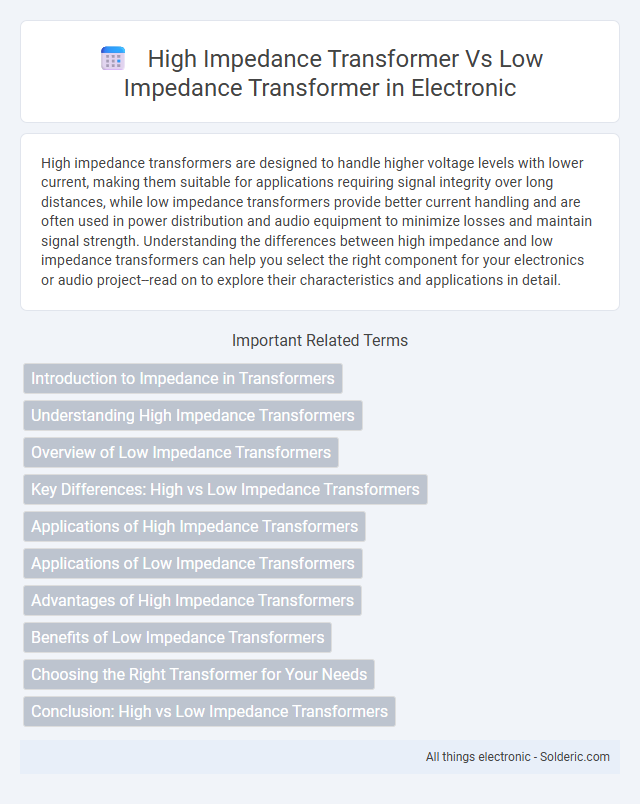High impedance transformers are designed to handle higher voltage levels with lower current, making them suitable for applications requiring signal integrity over long distances, while low impedance transformers provide better current handling and are often used in power distribution and audio equipment to minimize losses and maintain signal strength. Understanding the differences between high impedance and low impedance transformers can help you select the right component for your electronics or audio project--read on to explore their characteristics and applications in detail.
Comparison Table
| Feature | High Impedance Transformer | Low Impedance Transformer |
|---|---|---|
| Impedance Level | High (typically thousands of ohms) | Low (typically a few ohms to tens of ohms) |
| Application | Microphone preamps, guitar amplifiers, impedance matching for sensitive equipment | Power distribution, audio line matching, heavy power load applications |
| Signal Loss | Minimal signal degradation, suitable for low-level signals | Higher current capacity but may introduce minor losses in sensitive circuits |
| Size and Weight | Generally smaller and lighter due to fewer wire turns | Typically larger and heavier to handle higher currents |
| Noise Sensitivity | Higher susceptibility to noise, used in controlled environments | Lower noise sensitivity, better for industrial environments |
| Cost | Usually higher cost due to precise construction | More cost-effective for heavy-duty power applications |
| Energy Efficiency | Efficient for signal transfer in low-power circuits | Efficient for power transfer in high-current circuits |
Introduction to Impedance in Transformers
Impedance in transformers determines the voltage-current relationship and affects power transfer efficiency. High impedance transformers limit current flow, reducing short-circuit risks and improving safety in sensitive applications, while low impedance transformers allow higher current flow, supporting heavy load demands and minimizing voltage drops. Understanding your transformer's impedance is crucial for optimizing performance and ensuring compatibility with your electrical system.
Understanding High Impedance Transformers
High impedance transformers are designed to operate with circuits that have high electrical resistance, providing optimal signal transfer and voltage transformation without significant current flow. These transformers are commonly used in audio applications and impedance matching for sensitive equipment, where preserving signal integrity and minimizing noise is critical. Compared to low impedance transformers, high impedance types excel at handling higher voltage levels with lower current, ensuring effective isolation and reduced power loss in high-frequency systems.
Overview of Low Impedance Transformers
Low impedance transformers typically exhibit impedance values ranging from 1 to 10 ohms, allowing them to handle higher current loads with minimal voltage drop. Commonly used in power distribution and audio applications, these transformers provide efficient energy transfer with reduced losses and enhanced stability. Their design emphasizes robust winding configurations that support heavy-duty performance in industrial and commercial settings.
Key Differences: High vs Low Impedance Transformers
High impedance transformers have greater voltage levels with lower current capacity, making them ideal for long-distance transmission and signal isolation in sensitive electronics. Low impedance transformers offer higher current output and lower voltage, suitable for power distribution and heavy-load applications requiring efficient energy transfer. The core difference lies in their impedance values affecting voltage regulation, efficiency, and application suitability within electrical and audio systems.
Applications of High Impedance Transformers
High impedance transformers are primarily used in audio and signal processing applications where impedance matching is crucial to minimize signal loss and noise interference, such as in microphone systems and guitar amplifiers. These transformers enable optimal voltage transfer between high source impedances and lower load impedances, enhancing signal clarity and fidelity. Industrial measurement instruments also utilize high impedance transformers to isolate sensitive circuits and maintain accurate signal transmission.
Applications of Low Impedance Transformers
Low impedance transformers are commonly used in power distribution systems and industrial equipment due to their ability to handle high current loads with minimal voltage drop. Their low impedance reduces energy loss and improves stability in circuits supplying motors, generators, and heavy machinery. You benefit from enhanced efficiency and reduced heat generation when using low impedance transformers in applications requiring robust and reliable power transfer.
Advantages of High Impedance Transformers
High impedance transformers provide superior voltage regulation and enhanced fault tolerance, making them ideal for sensitive electronic equipment requiring stable voltage levels. They reduce short-circuit currents, minimizing damage risk and improving overall system safety. Their ability to handle load variations with minimal efficiency loss benefits applications where power quality and longevity are critical.
Benefits of Low Impedance Transformers
Low impedance transformers provide superior voltage regulation and higher efficiency in power distribution systems by minimizing voltage drops under load conditions. They enable better fault current management, improving protection coordination and reducing equipment damage risks. Their compatibility with high power applications and robust thermal performance make them ideal for industrial and commercial environments.
Choosing the Right Transformer for Your Needs
High impedance transformers are ideal for matching high-voltage, low-current signals, making them perfect for sensitive audio equipment and long-distance transmission where minimal signal loss is crucial. Low impedance transformers excel in driving heavy loads and are commonly used in power distribution and audio amplification systems requiring high current flow. Understanding your application's voltage and current requirements ensures you choose the transformer that maximizes efficiency and performance.
Conclusion: High vs Low Impedance Transformers
High impedance transformers are ideal for applications requiring better voltage regulation and minimal current flow, often used in long-distance transmission to reduce power loss. Low impedance transformers provide superior fault current capacity and are commonly employed in distribution systems to support heavy load demands and ensure system stability. Your choice depends on balancing efficiency, load requirements, and system protection priorities.
high impedance transformer vs low impedance transformer Infographic

 solderic.com
solderic.com